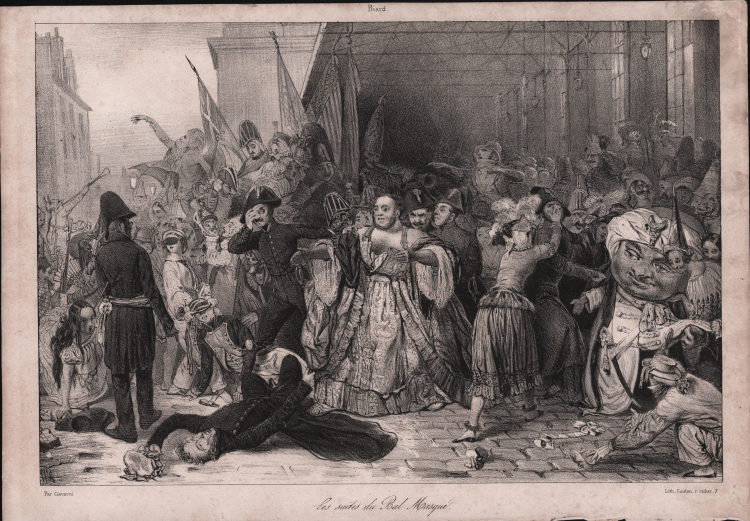



| Reference: | S5555 |
| Author | GAVARNI |
| Year: | 1839 |
| Measures: | 355 x 250 mm |


| Reference: | S5555 |
| Author | GAVARNI |
| Year: | 1839 |
| Measures: | 355 x 250 mm |
Lithograph, 1839, below the image: ‘Par Gavarni’ and ‘Lith. Coluon, r. richer, 7.’ After a painting by Biard
Paul Gavarni (Paris, 1804-1866) was the nom de plume of Sulpice Guillaume Chevalier (a French illustrator, born in Paris. About 1831 Gavarni began publishing his scenes of everyday contemporary life, and praise from writers such as Honoré de Balzac gained him popularity. In 1833 he began publication of the Journal of High Society, which failed after 18 numbers and was responsible for Gavarni’s imprisonment for debt in 1835 for almost a year. From 1839 to 1846 he issued his famous series Les Lorettes, Les Débardeurs, and Les Fourberies de femmes (“The Deceit of Women”). After the death of his mother and the end of his marriage, about 1845, his style changed, deepening in seriousness and subtlety. Enhanced by his deeper insight into human nature, Gavarni’s compositions of this time ironically depict the grotesque sides of family life and generally bear the stamp of a bitter philosophy. In 1847 he went to London, and he spent his time in England observing the life of the poor and producing some of his most compelling work. After his return to Paris he devoted more time to watercolour and in 1851 met the Goncourt brothers, who had long been his admirers; their book Gavarni: The Man and the Work appeared in 1873. Again Gavarni took up lithography, and in the periodical Paris he brought forth another of his great series, Masques et visages (1852–53). At the time of his death he was working in etching, lithography, and a new process, electric engraving.
|
French lithographer and painter. He was one of the most highly esteemed artists of the 19th century. Like Daumier, with whom he is often compared, he produced around 4000 lithographs for satirical journals and fashion magazines, but while Daumier concentrated on giving a panoramic view of public life, it was said of Gavarni that his work constituted the 'memoirs of the private life of the 19th century'. He specialized in genre scenes, in which the protagonists are usually young women, treating them as little dramatic episodes drawn from the light-hearted life of bohemia, dear to the Romantics.
|
|
French lithographer and painter. He was one of the most highly esteemed artists of the 19th century. Like Daumier, with whom he is often compared, he produced around 4000 lithographs for satirical journals and fashion magazines, but while Daumier concentrated on giving a panoramic view of public life, it was said of Gavarni that his work constituted the 'memoirs of the private life of the 19th century'. He specialized in genre scenes, in which the protagonists are usually young women, treating them as little dramatic episodes drawn from the light-hearted life of bohemia, dear to the Romantics.
|